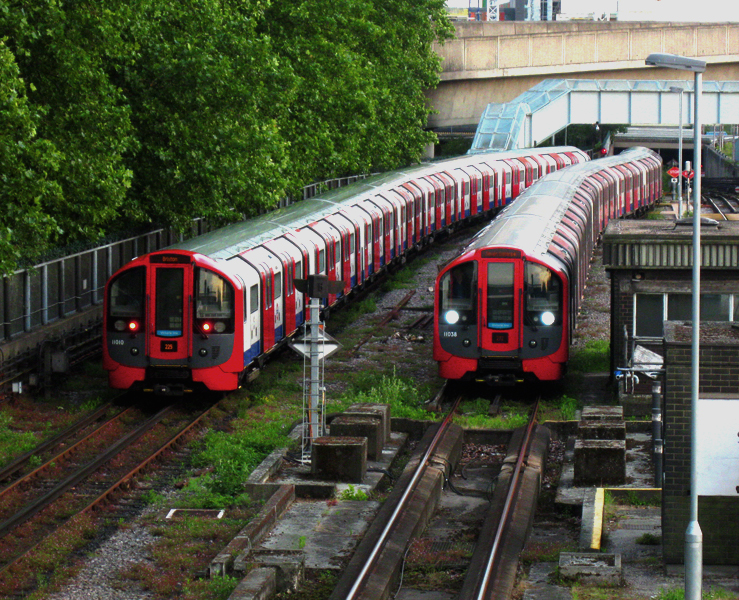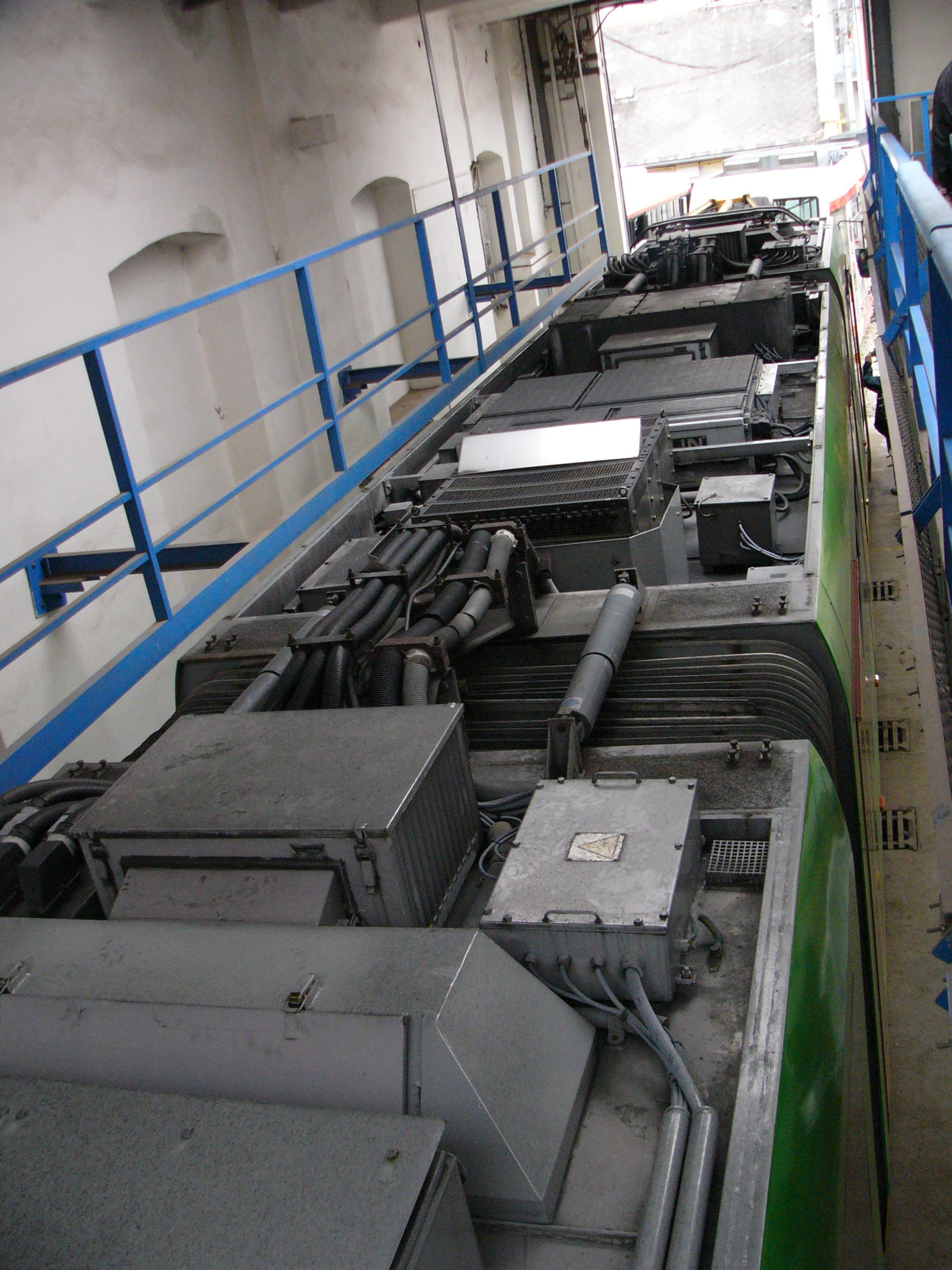|
London Tube Rolling Stock
London Underground rolling stock includes the electric multiple-unit trains used on the London Underground. These come in two sizes, smaller deep-level tube trains and larger sub-surface trains of a similar size to those on British main lines, both running on standard gauge tracks. New trains are designed for the maximum number of standing passengers and for speed of access to the cars. The first underground passenger services started in 1863 when the Metropolitan Railway opened using steam locomotives hauling gas-lit wooden carriages, braked from a guards' compartment. In 1890, the City and South London Railway opened the world's first deep-level tube railway, using electric locomotives pulling carriages with small windows, nicknamed "padded cells". Other tube railways opened in the early 20th century using electric multiple units known as 'gate stock', as access to them was via lattice gates at each end of the car. The earlier railways had electrified the underground sectio ... [...More Info...] [...Related Items...] OR: [Wikipedia] [Google] [Baidu] |
London Underground S7 And S8 Stock
The London Underground S7 and S8 Stock, commonly referred to as S Stock, is a type of passenger train running on the London Underground's subsurface lines since 2010. Manufactured by Bombardier Transportation's Derby Litchurch Lane Works, the S Stock was ordered to replace the A60, A62, C69, C77 and D78 stock on the Circle, District, Hammersmith & City and Metropolitan lines, which all dated from the 1960s and 1970s. The order was for a total of 192 trains (1,403 cars), and consisted of two types, S7 Stock for the Circle, District and Hammersmith & City lines, and S8 Stock for the Metropolitan line, with differences in the arrangement of seating and number of cars. Both types have air-conditioning and lower floors to ease accessibility for people with disabilities, and also have open gangways to allow passengers to move from one car to another whilst the train is moving. The order was said to be the biggest single rolling-stock order in Britain at a cost of £1.5 billio ... [...More Info...] [...Related Items...] OR: [Wikipedia] [Google] [Baidu] |
London Underground 1996 Stock
The London Underground 1996 Stock is a type of rolling stock used on the Jubilee line of the London Underground. The trains were built by GEC Alstom- Metro-Cammell and entered service in 1997. They are externally similar to the 1995 Stock used on the Northern line. The original 59 trains were initially built as 6-car trains. In 2005, an additional trailer car was added to lengthen each train to 7-cars and four additional 7-car trains delivered, bringing the total to 63 7-car trains. History The 1996 stock was ordered for the opening of the Jubilee Line Extension (JLE) from Green Park to Stratford. The original plan was to heavily refurbish the original 1983 stock with similar exteriors and interiors to the 1996 stock, and replace the single-leaf doors with double doors, but this proved too expensive and was abandoned. Delays in the construction of the JLE meant that the 1996 stock entered service on the existing Jubilee line, replacing the 1983 stock, well before the JLE ... [...More Info...] [...Related Items...] OR: [Wikipedia] [Google] [Baidu] |
Department For Transport
The Department for Transport (DfT) is a Departments of the Government of the United Kingdom, ministerial department of the Government of the United Kingdom. It is responsible for the English transport network and a limited number of transport matters in Scotland, Wales, and Northern Ireland that have not been Devolution#United Kingdom, devolved. The department is led by the Secretary of State for Transport. The expenditure, administration, and policy of the Department of Transport are scrutinised by the Transport Committee. Responsibilities The Department for Transport has six strategic objectives: * Support the creation of a stronger, cleaner, more productive economy * Help to connect people and places, balancing investment across the country * Make journeys easier, modern and reliable * Make sure transport is safe, secure and sustainable * Prepare the transport system for technological progress and a prosperous future outside the EU * Promote a culture of efficiency and pro ... [...More Info...] [...Related Items...] OR: [Wikipedia] [Google] [Baidu] |
Rail Vehicle Accessibility Regulations
The Rail Vehicle Accessibility (Non-Interoperable Rail System) Regulations 2010 (commonly known as RVAR 2010) is a statutory instrument in the United Kingdom. It aims to set standards designed to improve accessibility for disabled people on light rail passenger vehicles. It came into force on 6 April 2010. The instrument exercises powers conferred by the Disability Discrimination Act 1995. It revokes and replaces the Rail Vehicle Accessibility Regulations 1998. Applicability RVAR 2010 sets standards designed to improve accessibility for disabled people on light rail vehicle systems for passengers, including metro, underground and tram A tram (also known as a streetcar or trolley in Canada and the United States) is an urban rail transit in which Rolling stock, vehicles, whether individual railcars or multiple-unit trains, run on tramway tracks on urban public streets; some ... systems, which are not subject to the Railways (Interoperability) Regulations 2006 ( PRM- ... [...More Info...] [...Related Items...] OR: [Wikipedia] [Google] [Baidu] |
Modern Railways
''Modern Railways'' is a monthly British magazine covering the rail transport industry, which was published by Ian Allan until March 2012 and Key Publishing since then. It has been published since 1962. The magazine was based originally in Shepperton, Surrey, and Tunbridge Wells subsequently. The magazine has always been targeted at both railway professionals and serious amateurs, an aim which derives from its origins as an amalgamation of the enthusiast magazine '' Trains Illustrated'' and the industry journal ''The Locomotive'' in the hands of its first editor Geoffrey Freeman Allen. It is currently edited by Richard Clinnick. Regular contributors include Roger Ford, Ian Walmsley, Alan Williams and Tony Miles. ''Informed Sources'' is a large section written regularly by Roger Ford and ''Pan Up'' is written by Ian Walmsley. Trains Illustrated The first edition of '' Trains Illustrated'' was published at the beginning of 1946. Due to post-war paper shortages, issues 1 to 8 ... [...More Info...] [...Related Items...] OR: [Wikipedia] [Google] [Baidu] |
Regenerative Braking
Regenerative braking is an energy recovery mechanism that slows down a moving vehicle or object by converting its kinetic energy or potential energy into a form that can be either used immediately or stored until needed. Typically, regenerative brakes work by driving an electric motor in reverse to recapture energy that would otherwise be lost as heat during braking, effectively turning the traction motor into a generator. Feeding power backwards through the system like this allows the energy harvested from deceleration to resupply an energy storage solution such as a battery or a capacitor. Once stored, this power can then be later used to aid forward propulsion. Because of the electrified vehicle architecture required for such a braking system, automotive regenerative brakes are most commonly found on hybrid and electric vehicles. This method contrasts with conventional braking systems, where excess kinetic energy is converted to unwanted and wasted heat due to friction i ... [...More Info...] [...Related Items...] OR: [Wikipedia] [Google] [Baidu] |
Waterloo & City Line
The Waterloo & City line, colloquially known as The Drain, is a shuttle line of the London Underground that runs between Waterloo and Bank stations with no intermediate stops. Its primary traffic consists of commuters from south-west London, Surrey and Hampshire arriving at Waterloo main line station and travelling forward to the City of London financial district. For this reason, the line has historically not operated on Sundays or public holidays, except in very limited circumstances. Following the COVID-19 pandemic, the line is currently only open on weekdays. It is one of only two lines on the Underground network to run completely underground, the other being the Victoria line. Printed in turquoise on the Tube map, it is by far the shortest line on the Underground network, being long, with an end-to-end journey lasting just four minutes. In absolute terms, it is the least-used Tube line, carrying just over 17 million passengers annually. However, in terms of the a ... [...More Info...] [...Related Items...] OR: [Wikipedia] [Google] [Baidu] |
Electric Multiple Units
An electric multiple unit or EMU is a multiple-unit train consisting of self-propelled carriages using electricity as the motive power. An EMU requires no separate locomotive, as electric traction motors are incorporated within one or a number of the carriages. An EMU is usually formed of two or more semi-permanently coupled carriages. However, electrically powered single-unit railcars are also generally classed as EMUs. The vast majority of EMUs are passenger trains but versions also exist for carrying mail. EMUs are popular on intercity, commuter, and suburban rail networks around the world due to their fast acceleration and pollution-free operation, and are used on most rapid-transit systems. Being quieter than diesel multiple units (DMUs) and locomotive-hauled trains, EMUs can operate later at night and more frequently without disturbing nearby residents. In addition, tunnel design for EMU trains is simpler as no provision is needed for exhausting fumes, although retrofitti ... [...More Info...] [...Related Items...] OR: [Wikipedia] [Google] [Baidu] |
New Tube For London
The London Underground 2024 Stock, known during development as the New Tube for London (NTfL), is a type of London Underground rolling stock built by Siemens Mobility at its facilities in Goole, United Kingdom and Vienna, Austria. It is part of the Siemens Inspiro family of metro and rapid-transport trains. An initial batch of 94 nine-car trains has been ordered at a cost of £1.5billion to replace 1973 Stock trains on the Piccadilly line, with options for a total of 250 trains allowing replacement of all existing trains on the deep-level Central, Waterloo & City and Bakerloo lines. The first train was delivered for testing in London in October 2024. Planned starting date for the service is the end of 2025, first on the Piccadilly line, with full deployment by the end of 2027. The trains will enter service with a train driver, with future potential for driverless operation. History Background In the late 1990s, the Labour government initiated a public–private pa ... [...More Info...] [...Related Items...] OR: [Wikipedia] [Google] [Baidu] |
Piccadilly Line
The Piccadilly line is a Deep level underground, deep-level London Underground line running between the west and the north of London. It has two western branches which split at Acton Town tube station, Acton Town and serves 53 stations. The line serves Heathrow Airport, and some of its stations are near tourist attractions in Central London such as Piccadilly Circus and Buckingham Palace. The District line, District and Metropolitan line, Metropolitan lines share some sections of track with the Piccadilly line. Printed in dark blue (officially "Corporate Blue", Pantone 072) on the Tube map, it is the sixth-busiest line on the Underground network, with nearly 218 million passenger journeys in 2019. The first section, between Finsbury Park station, Finsbury Park and Hammersmith tube station (District and Piccadilly lines), Hammersmith, was opened in 1906 as the Great Northern, Piccadilly and Brompton Railway (GNP&BR). The station tunnels and buildings were designed by Leslie Gree ... [...More Info...] [...Related Items...] OR: [Wikipedia] [Google] [Baidu] |



